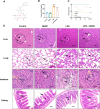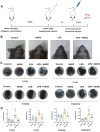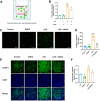Neohesperidin Dihydrochalcone Alleviates Lipopolysaccharide-Induced Vascular Endothelium Dysfunction by Regulating Antioxidant Capacity
- PMID: 39699295
- PMCID: PMC11656606
- DOI: 10.1002/iid3.70107
Neohesperidin Dihydrochalcone Alleviates Lipopolysaccharide-Induced Vascular Endothelium Dysfunction by Regulating Antioxidant Capacity
Abstract
Background: Endothelial dysfunction is one of the important mechanisms of organ and tissue damage in sepsis. In this study, we evaluated the effects of neohesperidin dihydrochalone (NHDC) on lipopolysaccharide (LPS)-induced vascular dysfunction and explored the potential mechanisms.
Methods: In vivo, we assessed vascular leakage in mice by injecting Evans blue dye. In vitro, cell counting kit-8 (CCK-8) assay and flow cytometry were used to assess the activity of HUVEC and apoptosis. The effect of LPS on HUVEC barrier was assessed using FITC-extend membrane assay. The adhesion ability of HUVEC was tested by THP-1 cell adhesion assay. The antioxidant capacity of cells was measured by detecting the level of mitochondrial membrane potential, ROS, and content of CAT, SOD, GSH, and MDA within the cells. Furthermore, the release of endothelial IL-1β, IL-6, and TNF-α were detected by ELISA, and the expression level of TAK1, ERK1/2, and NFκB were detected by western blot.
Results: Treatment with NHDC effectively alleviated LPS-induced endothelial permeability and organ damage by reducing reactive oxygen species production and enhancing the antioxidant response. Further investigation suggested that NHDC may exert its protective effects by inhibiting the release of IL-1β, IL-6, and TNF-α, and by decreasing the phosphorylation of key inflammatory signaling molecules, including transforming growth factor-β-activated kinase 1 (TAK1), extracellular signal-regulated kinases 1/2 (ERK1/2), and nuclear factor kappa B (NFκB).
Conclusions: Our study indicate that pretreatment with NHDC may provide protection against LPS-induced vascular dysfunction by reducing oxidative stress and activation of inflammatory signaling pathways.
Keywords: endothelial dysfunction; inflammation; neohesperidin dihydrochalcone; oxidative stress; sepsis.
© 2024 The Author(s). Immunity, Inflammation and Disease published by John Wiley & Sons Ltd.
Conflict of interest statement
The authors declare no conflicts of interest.
Figures







Similar articles
-
4-Octyl itaconate alleviates endothelial cell inflammation and barrier dysfunction in LPS-induced sepsis via modulating TLR4/MAPK/NF-κB signaling : 4-Octyl itaconate alleviates endothelial dysfunction.Mol Med. 2025 Jun 16;31(1):240. doi: 10.1186/s10020-025-01160-2. Mol Med. 2025. PMID: 40524158 Free PMC article.
-
Artificial sweetener neohesperidin dihydrochalcone showed antioxidative, anti-inflammatory and anti-apoptosis effects against paraquat-induced liver injury in mice.Int Immunopharmacol. 2015 Dec;29(2):722-729. doi: 10.1016/j.intimp.2015.09.003. Epub 2015 Sep 9. Int Immunopharmacol. 2015. PMID: 26362205
-
Neohesperidin dihydrochalcone down-regulates MyD88-dependent and -independent signaling by inhibiting endotoxin-induced trafficking of TLR4 to lipid rafts.Free Radic Biol Med. 2015 Dec;89:522-32. doi: 10.1016/j.freeradbiomed.2015.08.023. Epub 2015 Oct 8. Free Radic Biol Med. 2015. PMID: 26453923
-
[Effect of rivaroxaban on the injury during endotoxin-induced damage to human umbilical vein endothelial cells].Zhonghua Wei Zhong Bing Ji Jiu Yi Xue. 2019 Apr;31(4):468-473. doi: 10.3760/cma.j.issn.2095-4352.2019.04.019. Zhonghua Wei Zhong Bing Ji Jiu Yi Xue. 2019. PMID: 31109423 Chinese.
-
Causation by Diesel Exhaust Particles of Endothelial Dysfunctions in Cytotoxicity, Pro-inflammation, Permeability, and Apoptosis Induced by ROS Generation.Cardiovasc Toxicol. 2017 Oct;17(4):384-392. doi: 10.1007/s12012-016-9364-0. Cardiovasc Toxicol. 2017. PMID: 26965709 Review.
Cited by
-
Association of advanced lung cancer inflammation index with all-cause and cardiovascular mortality in metabolic dysfunction associated steatotic liver disease.Sci Rep. 2025 Apr 29;15(1):15121. doi: 10.1038/s41598-025-99311-2. Sci Rep. 2025. PMID: 40301487 Free PMC article.
References
-
- Lelubre C. and Vincent J. L., “Mechanisms and Treatment of Organ Failure in Sepsis,” Nature Reviews Nephrology 14, no. 7 (2018): 417–427. - PubMed
-
- Taghavi S., Abdullah S., Shaheen F., et al., “Exosomes and Microvesicles From Adipose‐Derived Mesenchymal Stem Cells Protects the Endothelial Glycocalyx From Lps Injury,” Shock 60, no. 1 (2023): 56–63. - PubMed
-
- Khakpour S., Wilhelmsen K., and Hellman J., “Vascular Endothelial Cell Toll‐Like Receptor Pathways in Sepsis,” Innate Immunity 21, no. 8 (2015): 827–846. - PubMed
-
- Frydman A., Weisshaus O., Huhman D. V., et al., “Metabolic Engineering of Plant Cells for Biotransformation of Hesperedin Into Neohesperidin, a Substrate for Production of the Low‐Calorie Sweetener and Flavor Enhancer NHDC,” Journal of Agricultural and Food Chemistry 53, no. 25 (2005): 9708–9712. - PubMed
Publication types
MeSH terms
Substances
LinkOut - more resources
Full Text Sources
Medical
Miscellaneous

